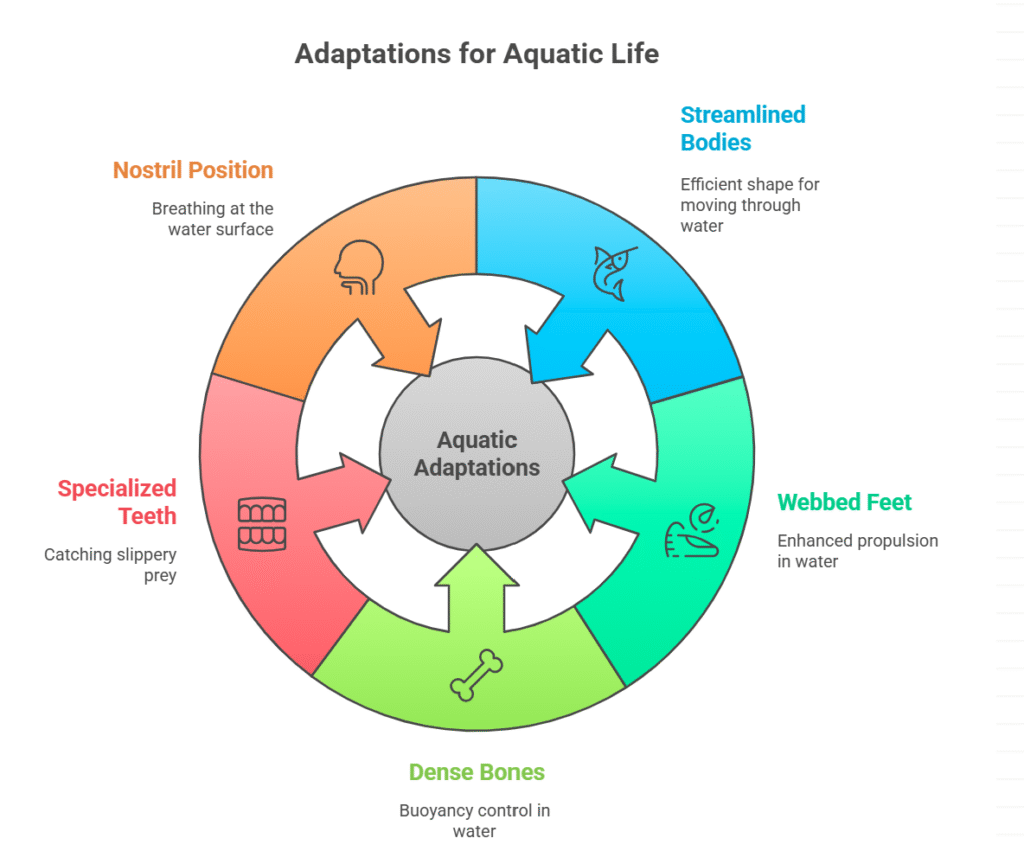Millions of years ago, Earth’s landscapes were dotted with rivers, lakes, and vast inland seas. As environments changed, some dinosaurs began to exploit these watery habitats. Over time, certain species developed features that made them better swimmers webbed feet, streamlined bodies, and even paddle-like tails.
One of the most famous examples is Spinosaurus, a massive predator that’s often called the “first swimming dinosaur.” Recent fossil evidence suggests Spinosaurus spent much of its life in water, hunting fish and using its long, crocodile-like snout to snatch prey.
Real-Life Example: The Spinosaurus Debate
A paleontologist once shared, “When we found the Spinosaurus tail fossils, it was a game-changer. Suddenly, we realized this dinosaur was more at home in the water than we ever imagined.” This discovery sparked a wave of excitement and debate among scientists and dinosaur fans alike.
Meet the Most Famous Aquatic Dinosaurs
Spinosaurus: The River Monster
Spinosaurus is the poster child for aquatic dinosaurs. Measuring up to 50 feet long, it was larger than T. rex and had a distinctive sail on its back. Its bones show adaptations for swimming, including dense limb bones and a powerful, paddle-shaped tail.
Baryonyx: The Fish Hunter
Another fascinating swimming dinosaur is Baryonyx, known for its long, hooked claws and fish-filled stomach fossils. Baryonyx likely waded in shallow waters, using its claws to snag slippery prey.
Halszkaraptor: The “Dino-Duck”
Discovered in Mongolia, Halszkaraptor is a small, bird-like dinosaur with features similar to modern waterfowl. Its long neck and flipper-like arms suggest it was an agile swimmer, possibly diving for fish like a prehistoric duck.
Not All Water Dinosaurs Were Dinosaurs: Meet the Marine Reptiles
While Spinosaurus and its kin were true dinosaurs, most of the classic “sea monsters” were actually marine reptiles. Let’s meet a few:
Plesiosaurs: The Long-Necked Swimmers
With their snake-like necks and broad, paddle-shaped limbs, plesiosaurs are often mistaken for aquatic dinosaurs. These creatures glided through ancient seas, snapping up fish and squid.
Mosasaurs: The Apex Predators
Mosasaurs were giant, lizard-like marine reptiles that dominated the oceans at the end of the Cretaceous period. Some grew over 50 feet long and had double-hinged jaws, allowing them to swallow prey whole.
Ichthyosaurs: The Dolphin-Like Reptiles
Resembling modern dolphins, ichthyosaurs were fast, agile swimmers. They gave birth to live young and had large eyes for hunting in deep, dark waters.
How Did Aquatic Dinosaurs and Marine Reptiles Survive Underwater?
Adaptations for Life in Water
Whether they were true aquatic dinosaurs or marine reptiles, these prehistoric creatures developed remarkable adaptations for underwater life:
- Streamlined bodies for efficient swimming
- Webbed feet or flippers for propulsion
- Dense bones to help with buoyancy control
- Specialized teeth for catching slippery prey
- Nostrils positioned for surface breathing
Some, like Spinosaurus, even had sensory adaptations in their snouts to detect movement in water—much like modern crocodiles.

The Science of Swimming Dinosaurs: What Fossils Reveal
Fossil Evidence: Piecing Together the Past
Paleontologists rely on fossils to reconstruct the lives of aquatic dinosaurs. Tail shapes, limb bones, and even stomach contents provide clues about how these animals lived and hunted.
For example, the discovery of a Spinosaurus tail with tall, flat vertebrae was a breakthrough, showing it could move side-to-side like a giant paddle. Similarly, Baryonyx fossils with fish scales in their stomachs confirm their diet.
Underwater Dinosaurs in Popular Culture
Movies and documentaries often blur the lines between fact and fiction. While Jurassic Park made mosasaurs famous, it’s important to remember that not all “water dinosaurs” were actually dinosaurs. Still, the fascination with these creatures continues to inspire new generations of paleontologists.
The Debate: Were There Truly Aquatic Dinosaurs?
The Expert Perspective
Some scientists argue that while a few dinosaurs were semi-aquatic, none were fully adapted to life underwater like marine reptiles. Others point to new fossil evidence suggesting that certain species, like Spinosaurus, spent most of their lives in water.
The debate is ongoing, but one thing’s clear: the line between land and water was often blurred in the age of dinosaurs.
Real-Life Reflections: What Fans Say About Aquatic Dinosaurs
On social media, one user wrote, “I always thought dinosaurs were land animals, but learning about swimming dinosaurs blew my mind. Spinosaurus is my new favorite!” This excitement is echoed by many who discover the watery side of dinosaur history for the first time.
Risks and Challenges: Life as an Underwater Dinosaur
Predators and Prey
Life in ancient waters wasn’t easy. Aquatic dinosaurs and marine reptiles faced fierce competition from other predators, including giant fish, sharks, and even each other.
Environmental Changes
Shifting climates and changing sea levels meant that habitats could disappear almost overnight. Adaptability was key to survival, and those that couldn’t keep up often went extinct.
The Legacy of Aquatic Dinosaurs in 2025
Why Do We Still Care?
In 2025, the study of aquatic dinosaurs is more exciting than ever. New technologies, like 3D scanning and advanced imaging, allow scientists to uncover details that were once impossible to see. Each new discovery adds another piece to the puzzle, helping us understand not just how these creatures lived, but how life on Earth has evolved.
The Ongoing Search
Paleontologists continue to search for fossils in riverbeds, deserts, and even underwater. Every new find has the potential to rewrite what we know about swimming dinosaurs and their world.
The Most Famous Water Dinosaurs and Marine Reptiles: A Quick Guide
- Spinosaurus: The largest known swimming dinosaur, with a crocodile-like snout and sail.
- Baryonyx: A fish-eating dinosaur with massive claws.
- Halszkaraptor: A small, duck-like swimmer.
- Plesiosaur: Not a dinosaur, but a long-necked marine reptile.
- Mosasaur: The “T. rex of the seas,” a giant marine lizard.
- Ichthyosaur: Dolphin-shaped, fast-swimming marine reptile.
The Future of Aquatic Dinosaur Research
What’s Next?
With each passing year, new discoveries challenge what we thought we knew about aquatic dinosaurs. In 2025, researchers are using AI to analyze fossil data, drones to map dig sites, and even underwater robots to search for fossils in ancient seabeds.
How You Can Get Involved
Many museums and universities offer citizen science programs, where you can help identify fossils or even join a dig. Who knows? The next big discovery could have your name on it.
FAQs
Q. Were there really aquatic dinosaurs?
A. Yes, some dinosaurs like Spinosaurus and Baryonyx were adapted for life in water, but most “water dinosaurs” were actually marine reptiles like plesiosaurs and mosasaurs.
Q. What’s the difference between aquatic dinosaurs and marine reptiles?
A. Aquatic dinosaurs were true dinosaurs that adapted to water, while marine reptiles (like plesiosaurs and ichthyosaurs) were separate groups that lived entirely in aquatic environments.
Q. Which was the largest swimming dinosaur?
A. Spinosaurus is currently considered the largest swimming dinosaur, reaching lengths of up to 50 feet.
Q. Did underwater dinosaurs breathe underwater?
A. No, even aquatic dinosaurs and marine reptiles breathed air. They had to surface regularly, much like modern whales and crocodiles.
Final Thoughts
Aquatic dinosaurs is one of adaptation, survival, and the endless wonders of evolution. From the mighty Spinosaurus to the sleek ichthyosaur, these creatures remind us that life is always changing, always finding new ways to thrive.
CLICK HERE FOR MORE BLOG POSTS
“In a world of instant takes and AI-generated noise, John Authers writes like a human. His words carry weight—not just from knowledge, but from care. Readers don’t come to him for headlines; they come for meaning. He doesn’t just explain what happened—he helps you understand why it matters. That’s what sets him apart.”

